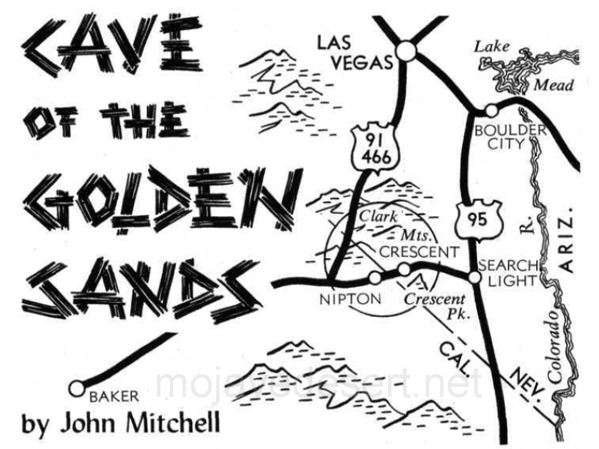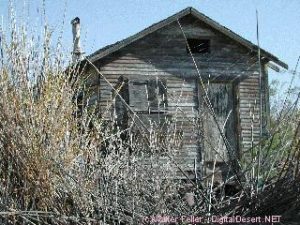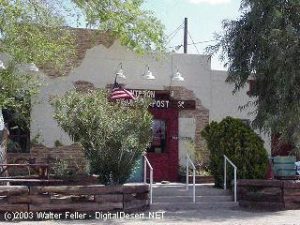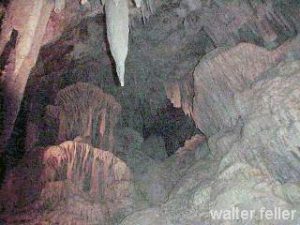by John Mitchell – Desert Magazine, December 1967
Fifty years ago, about the time the Salt Lake railroad was being built from Salt Lake City to
San Pedro, California, many small mining camps were springing up all along the line and the hills were full of prospectors. An old man with long white whiskers, mounted on a burro and driving four others ahead of him, showed up at the little mining camp of Crescent, Nevada. After watering his burros at the water trough near the windmill he pulled off to one side and made camp. By the time his burros were unpacked and hobbled and the campfire going, Winfield Sherman, Ike Reynolds, Bert Cavanaugh, Jim Wilson and the writer had gathered around to pass the time of day with the newcomer.
During the conversation, which was carried on mostly by Winfield Sherman, a typical long-haired, bewhiskered desert rat, the old prospector volunteered the information that his name was Riley Hatfield, that he hailed from Raleigh, North Carolina, and that he had come out west on the advice of the family doctor. He said he was headed for Searchlight, Nevada, to purchase provisions and to see a doctor about a heart ailment that had been troubling him.

The old man was very polite, had a good outfit and looked prosperous. However, he did not seem to be much interested in the Crescent camp despite the buildup we old-timers had given it while sitting around the campfire.

The old man broke camp shortly after breakfast the next morning and by sunup was headed out over the trail in the direction of Searchlight. Two days later the writer happened to be in Searchlight to pick up mail and provisions and met the prospector at Jack Wheatley’s boarding
house.
After dinner I joined the old man on the front porch for a smoke and a little chat. During the conversation he told me he had some placer gold for sale and asked me if I knew anyone who would buy it. I referred him to the assay office at either the Duplex or Quartette mine. Later that afternoon he told me he had sold the gold at the Duplex assay office. He reached into his pocket and pulled out five or six of the most beautiful gold nuggets I had ever seen. He said he was sending them to a friend.
I saw the prospector several times the following day and late that afternoon he told me he had purchased his supplies and had seen a doctor and would be ready to pull out early the next day. He asked me to accompany him as far as Crescent where I had my own camp.
After breakfast the next morning we headed our two pack outfits in the direction of Crescent Peak 14 miles west.

About noon we stopped for lunch and to give the burros a chance to browse. While the bacon was sizzling and the coffee pot was sputtering the old man told me he had discovered four pounds of gold nuggets in a black sand deposit near the Clark Mountains northeast of
Nippeno (now called Nipton.) He invited me to go with him as he did not like to be out in the desert alone.
He said that one day while camped just below Clark Peak, he climbed a short way up the mountainside and saw off to the east a dry lake bed that suddenly filled with water. It looked so real he could see trees along the shore and their reflection in the water.
The route he was following to Crescent and Searchlight was in that general direction so he decided to investigate the lake or whatever it was. As he approached the lake later it had entirely disappeared, and he then realized that it was only a beautiful mirage. Fortunately he had brought a good supply of water along. About noon while skirting the western edge of the dry lake bed he saw what seemed to be the entrance to a cave on the east side of a small limestone hill about 50 feet above the level of the dry lake bed.
There is something interesting about a cave. It may contain anything—an iron-bound chest full of gold and silver and precious gems, bandit loot, old guns, saddles, artifacts, bones of man or long extinct animals. I sometimes think this love of the cave has been handed down to us by ancient ancestors who lived in caves. When one of those old-timers headed for his cave two jumps ahead of a three-toed whang-doodle the cave looked good to him.
Likewise this cave looked good to the old prospector and he decided to make camp and explore it. At least it offered shelter from desert sand storms.
The entrance was a long tunnel. He had not gone far inside when he heard the sound of running water. Returning to the mouth of the cave for a lantern, he made his way back along the narrow entrance and soon came to a great dome-shaped chamber resembling an amphitheatre full of churning water. As he stood there a small whirlpool appeared in the center and suddenly the water rushed out with a roar like thunder. The bottom seemed to have dropped out of the cave. The floor was shaped like a large basin with bench-like terraces or
steps that led down to the dark center. The terraces were piled high with black sand that trickled down with the receding water.

Hanging from the ceiling were thousands of beautiful stalactites while other thousands of stalagmites stood up from the floor of the cave. In places they formed massive columns. Around the interior of the cavern were many grottos sparkling with crystals. The walls were
plastered with lime carbonate like tapestries studded with diamonds. Never in his life had he seen anything like it. Above the top terrace was a human skeleton and in a nearby grotto were the bones of some extinct animal, probably a ground sloth.

The center of the basin-shaped bottom of the cave was now filled with black sand that had slid down from the surrounding terraces. On the way out he gathered a few handfuls of the sand
which later was found to be sprinkled with yellow nuggets that gleamed in the desert sunlight. That night the old prospector sat by his campfire smoking and reveling in the dreams of a Monte Cristo. Was he not rich?
According to his story the water in the cavern rises and falls with the ebb and flow of the tides in the Pacific and is active twice every 24 hours. First a rumbling sound like a subterranean cannonading is heard coming from the dark interior and then suddenly the pile of black sand that chokes the tube-like chimney, is seen to rise up, and a dark column of water 18 feet in diameter bulges up from the center and reaches a height of 45 or 50 feet. This dome of
water and sand spreads out into waves and breaks into white spray as it dashes against the terraces. The play or intense agitation keeps up for several hours and then the pool settles down and is quiet as a millpond.
If the old man told the truth about the sand in the lake bed and in the cavern, it would be difficult to compute the value of the gold that could be taken from this cave. Then, too, every time the tide comes it brings up more gold. How far the black stream reaches down the underground stream, I am unable to say.
Our dinner was over by the time the old man had finished his story, and we began to break camp.
He invited me to go along with him to his cave and work with him. This I readily agreed to do as soon as I could sell my mining claims in the Crescent camp. The old man promised to be back in about three weeks with more gold at which time I hoped to be ready to accompany him.
I sold my claim to an old French Canadian named Joe Semenec, who was prospecting for a Dr. John Horsky, of Helena, Montana.
The old prospector never returned and to this date no word has ever come out of the desert as to his fate. I have since learned that an old man with long white whiskers was found dead on the dry lake bed near Ivanpah. He and his burros were shot to death. I do not know if this was the same man or not.
The old man had told me that there was from three to six feet of this heavy black sand on the dry lake bed, which is now covered by a shroud of snow white sand.
Naturally I do not know the exact location of this million dollar cave. If I did I would locate it myself instead of writing this story which will, no doubt, stir interest in that part of the desert. This cave should not be confused with one that recently was discovered out on Highway 91 east of San Bernardino, California, which is said to extend for a distance of eight miles and to contain a fortune in gold.
Some old prospector or desert rat with a magic lamp to transport him to this hole in the ground, could live like a king, if he had enough money to buy a small electric light plant, some rails and an ore car. He could live in a fairy palace with nothing to do but wait for the tide to come in with more gold.
Kokoweef
–.–